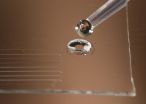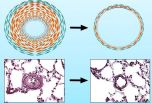(Press-News.org) The type of sound processing that modern hearings aids provide to make speech more understandable for wearers may also make music enjoyment more difficult, according to a new study by the University of Colorado Boulder.
The findings, published in the journal Ear and Hearing, suggest that less sophisticated hearing aids might actually be more compatible with listening to music, especially recorded music that has itself been processed to change the way it sounds.
"Hearing aids have gotten very advanced at processing sounds to make speech more understandable," said Naomi Croghan, who led the study as a doctoral student at CU-Boulder and who now works at Cochlear Americas in Centennial, Colorado. "But music is a different animal and hasn't always been part of the hearing aid design process."
A frequent complaint among people who use hearing aids is that music can sound distorted, said Croghan, and it's common for people to remove their hearing aids to listen to music.
Modern hearing aids use processing called "wide dynamic range compression," which leaves loud sounds untouched but amplifies softer sounds. This kind of processing is useful for helping people with hearing loss follow a conversation, but it can distort music, which often covers a wider range of volumes than speech.
Adding to the distortion is the fact that recorded music commonly undergoes its own processing, known as "compression limiting," which squeezes louder and softer sounds together into a narrower range, increasing the perceived volume. Too much compression limiting can affect the quality of music even for people with normal hearing, Croghan said, but it compounds the problem for hearing aid users.
"The recorded music is processed through multiple layers by the time the person with hearing loss actually hears it," Croghan said.
The research team—which also included Professor Kathryn Arehart and Scholar in Residence James Kates, both in CU-Boulder's Department of Speech, Language and Hearing Sciences—asked 18 experienced hearing aid users to listen to classical and rock music samples that ranged from being unprocessed to highly processed. The participants also used simulated hearing aids set at a variety of processing levels.
Regardless of which music sample the participants listened to, they generally preferred using the hearing aids with the simplest additional processing—essentially devices that just boost the volume. The participants also tended to prefer less processed music to more processed music. However, the level of processing of the music itself wasn't as important as the type of hearing aid used for listener enjoyment.
"What's interesting about this is that more is not necessarily better," Arehart said. "If I am in a noisy restaurant and I want to hear the people at my table, then more processing may be better in order to suppress the background noise. But when listening to music, more processing may actually do more harm than good."
Despite general agreement among study participants that less processing in the hearing aid was better for listening to music, individual preferences varied from person to person.
"When it comes to hearing, like a lot of things, the average result does not fit everyone," Croghan said.
INFORMATION:
The study was funded by a grant from hearing aid manufacturer GN ReSound.
The uncontrolled growth of cancer cells arises from their ability to hijack the cell's normal growth program and checkpoints. Usually after therapy, a second cancer-signaling pathway will open after the primary one shuts down — creating an ingenious escape route for the cancer cell to survive. The answer, say Case Western Reserve researchers, is to anticipate and block that back-up track by prescribing two drugs from the start. The results of the project, led by Ruth Keri, PhD, Professor and Vice Chair Department of Pharmacology, and Associate Director for Basic Research ...
Religious beliefs and practices may reduce thoughts of suicide among African-American adults in stressful life events induced by racial discrimination, according to a new research study conducted at the University of Houston (UH).
"African-Americans experience an inordinate amount of psychological strain through racial discrimination, leading to depression, hopelessness and other high risk factors for suicide, but demonstrate significantly lower rates of suicide relative to European-Americans," said Rheeda Walker, associate professor and director of the Culture, Risk ...
This news release is available in German.
While neurons rapidly propagate information in their interior via electrical signals, they communicate with each other at special contact points known as the synapses. Chemical messenger substances, the neurotransmitters, are stored in vesicles at the synapses. When a synapse becomes active, some of these vesicles fuse with the cell membrane and release their contents. To ensure that valuable time is not lost, synapses always have some readily releasable vesicles on standby. With the help of high-resolution, three-dimensional ...
VIDEO:
This animation of NOAA's GOES-West satellite imagery from Oct. 1 -27 shows the movement of Tropical Storm Ana as it heads toward British Columbia, Canada. TRT: 00:20.
Click here for more information.
An animation of imagery from NOAA's GOES-West satellite taken over the period of Oct.19 to 26 shows the movement, intensification, weakening and movement toward British Columbia, Canada. On Oct. 27, wind warnings were posted along some coastal sections of British Columbia.
During ...
When you flush the toilet, you may be discarding microscopic warning signs about your health.
But a cunningly simple new device can stop that vital information from "going to waste."
Brigham Young University chemist Adam Woolley and his students made a device that can detect markers of kidney disease and prostate cancer in a few minutes. All you have to do is drop a sample into a tiny tube and see how far it goes.
That's because the tube is lined with DNA sequences that will latch onto disease markers and nothing else. Urine from someone with a clean bill of health ...
This news release is available in German.
Pulmonary hypertension is characterised by uncontrolled division of cells in the blood vessel walls. As a result, the vessel walls become increasingly thick.
Scientists at the Max Planck Institute for Heart and Lung Research in Bad Nauheim and Giessen University have discovered that transcription factor FoxO1 regulates the division of cells and plays a key role in the development of pulmonary hypertension. The researchers were able to cure pulmonary hypertension in rats by activating FoxO1. The study findings could ...
A Johns Hopkins research team reports that major hospitals across the U.S. collectively throw away at least $15 million a year in unused operating room surgical supplies that could be salvaged and used to ease critical shortages, improve surgical care and boost public health in developing countries.
A report on the research, published online Oct. 16 in the World Journal of Surgery, highlights not only an opportunity for U.S. hospitals to help relieve the global burden of surgically treatable diseases, but also a means of reducing the cost and environmental impact of medical ...
Physicists in Syracuse University's College of Arts and Sciences have made important discoveries regarding Bs meson particles—something that may explain why the Universe contains more matter than antimatter.
Distinguished Professor Sheldon Stone and his colleagues recently announced their findings at a workshop at CERN in Geneva, Switzerland. Titled "Implications of LHCb Measurements and Their Future Prospects," the workshop enabled him and other members of the Large Hadron Collider beauty (LHCb) Collaboration to share recent data results.
The LHCb Collaboration ...
If you've ever broken a bone, there's a good chance you needed surgery, braces, or splints to realign the bone. Severe fractures in infants, on the other hand, can heal on their own through a process that has eluded scientists. A study published by Cell Press on October 27 in Developmental Cell reveals that a fractured arm bone in newborn mice can rapidly realign through a previously unknown mechanism involving bone growth and muscle contraction. The findings provide new insights into how human infants and other young vertebrates may repair broken bones and pave the way ...
Although Ibuprofen and oral morphine both provide effective pain relief for children with broken limbs, ibuprofen is the recommended choice because of adverse events associated with oral morphine, according to a randomized trial published in CMAJ (Canadian Medical Association Journal)
Fractures make up between 10% and 25% of all children's injuries, and the most severe pain is felt during the first 48 hours after the injury. Because of concerns about the safety of codeine for children, there is limited choice for medications to relieve pain for these patients.
"Evidence ...







